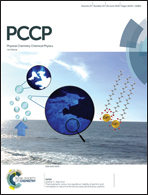The ozonolysis of isoprene in a cryogenic buffer gas cell by high resolution microwave spectroscopy†
Abstract
We have developed a method to quantify reaction product ratios using high resolution microwave spectroscopy in a cryogenic buffer gas cell. We demonstrate the power of this method with the study of the ozonolysis of isoprene, CH2![[double bond, length as m-dash]](https://www.rsc.org/images/entities/char_e001.gif) C(CH3)–CH
C(CH3)–CH![[double bond, length as m-dash]](https://www.rsc.org/images/entities/char_e001.gif) CH2, the most abundant, non-methane hydrocarbon emitted into the atmosphere by vegetation. Isoprene is an asymmetric diene, and reacts with O3 at the 1,2 position to produce methyl vinyl ketone (MVK), formaldehyde, and a pair of carbonyl oxides: [CH3CO–CH
CH2, the most abundant, non-methane hydrocarbon emitted into the atmosphere by vegetation. Isoprene is an asymmetric diene, and reacts with O3 at the 1,2 position to produce methyl vinyl ketone (MVK), formaldehyde, and a pair of carbonyl oxides: [CH3CO–CH![[double bond, length as m-dash]](https://www.rsc.org/images/entities/char_e001.gif) CH2 + CH2
CH2 + CH2![[double bond, length as m-dash]](https://www.rsc.org/images/entities/char_e001.gif) OO] + [CH2
OO] + [CH2![[double bond, length as m-dash]](https://www.rsc.org/images/entities/char_e001.gif) O + CH3COO–CH
O + CH3COO–CH![[double bond, length as m-dash]](https://www.rsc.org/images/entities/char_e001.gif) CH2]. Alternatively, O3 could attack at the 3,4 position to produce methacrolein (MACR), formaldehyde, and two carbonyl oxides [CH2
CH2]. Alternatively, O3 could attack at the 3,4 position to produce methacrolein (MACR), formaldehyde, and two carbonyl oxides [CH2![[double bond, length as m-dash]](https://www.rsc.org/images/entities/char_e001.gif) C(CH3)–CHO + CH2
C(CH3)–CHO + CH2![[double bond, length as m-dash]](https://www.rsc.org/images/entities/char_e001.gif) OO] + [CH2
OO] + [CH2![[double bond, length as m-dash]](https://www.rsc.org/images/entities/char_e001.gif) O + CH2
O + CH2![[double bond, length as m-dash]](https://www.rsc.org/images/entities/char_e001.gif) C(CH3)–CHOO]. Purified O3 and isoprene were mixed for approximately 10 seconds under dilute (1.5–4% in argon) continuous flow conditions in an alumina tube held at 298 K and 5 Torr. Products exiting the tube were rapidly slowed and cooled within the buffer gas cell by collisions with cryogenic (4–7 K) He. High resolution chirped pulse microwave detection between 12 and 26 GHz was used to achieve highly sensitive (ppb scale), isomer-specific product quantification. We observed a ratio of MACR to MVK of 2.1 ± 0.4 under 1 : 1 ozone to isoprene conditions and 2.1 ± 0.2 under 2 : 1 ozone to isoprene conditions, a finding which is consistent with previous experimental results. Additionally, we discuss relative quantities of formic acid (HCOOH), an isomer of CH2
C(CH3)–CHOO]. Purified O3 and isoprene were mixed for approximately 10 seconds under dilute (1.5–4% in argon) continuous flow conditions in an alumina tube held at 298 K and 5 Torr. Products exiting the tube were rapidly slowed and cooled within the buffer gas cell by collisions with cryogenic (4–7 K) He. High resolution chirped pulse microwave detection between 12 and 26 GHz was used to achieve highly sensitive (ppb scale), isomer-specific product quantification. We observed a ratio of MACR to MVK of 2.1 ± 0.4 under 1 : 1 ozone to isoprene conditions and 2.1 ± 0.2 under 2 : 1 ozone to isoprene conditions, a finding which is consistent with previous experimental results. Additionally, we discuss relative quantities of formic acid (HCOOH), an isomer of CH2![[double bond, length as m-dash]](https://www.rsc.org/images/entities/char_e001.gif) OO, and formaldehyde (CH2
OO, and formaldehyde (CH2![[double bond, length as m-dash]](https://www.rsc.org/images/entities/char_e001.gif) O) under varying experimental conditions, and characterize the spectroscopic parameters of the singly-substituted 13C trans-isoprene and 13C anti-periplanar-methacrolein species. This work has the potential to be extended towards a complete branching ratio analysis, as well towards the ability to isolate, identify, and quantify new reactive intermediates in the ozonolysis of alkenes.
O) under varying experimental conditions, and characterize the spectroscopic parameters of the singly-substituted 13C trans-isoprene and 13C anti-periplanar-methacrolein species. This work has the potential to be extended towards a complete branching ratio analysis, as well towards the ability to isolate, identify, and quantify new reactive intermediates in the ozonolysis of alkenes.



 Please wait while we load your content...
Please wait while we load your content...